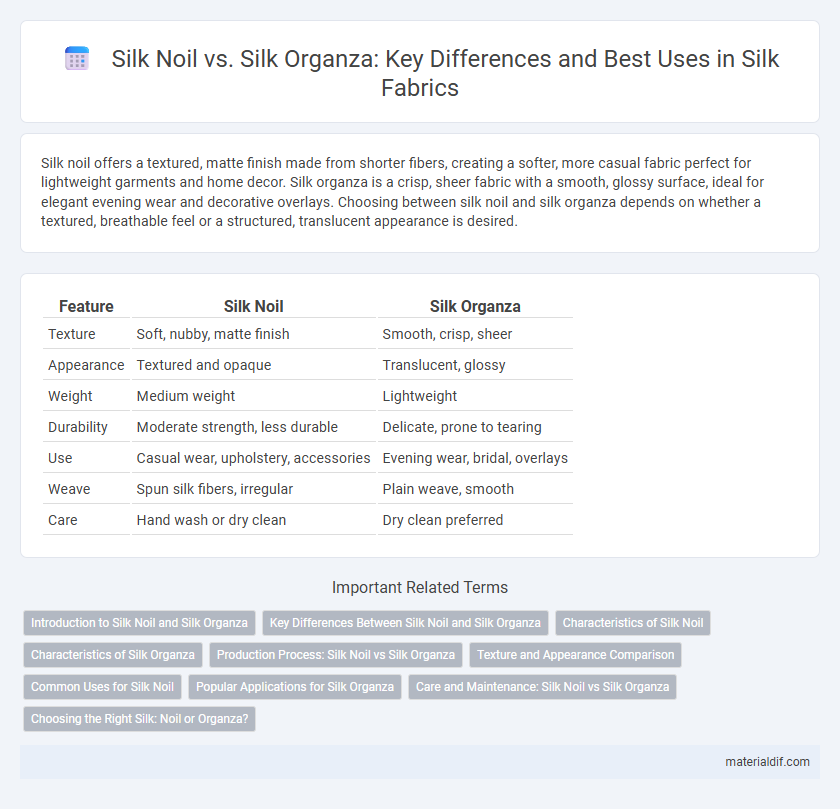Silk noil offers a textured, matte finish made from shorter fibers, creating a softer, more casual fabric perfect for lightweight garments and home decor. Silk organza is a crisp, sheer fabric with a smooth, glossy surface, ideal for elegant evening wear and decorative overlays. Choosing between silk noil and silk organza depends on whether a textured, breathable feel or a structured, translucent appearance is desired.
Table of Comparison
| Feature | Silk Noil | Silk Organza |
|---|---|---|
| Texture | Soft, nubby, matte finish | Smooth, crisp, sheer |
| Appearance | Textured and opaque | Translucent, glossy |
| Weight | Medium weight | Lightweight |
| Durability | Moderate strength, less durable | Delicate, prone to tearing |
| Use | Casual wear, upholstery, accessories | Evening wear, bridal, overlays |
| Weave | Spun silk fibers, irregular | Plain weave, smooth |
| Care | Hand wash or dry clean | Dry clean preferred |
Introduction to Silk Noil and Silk Organza
Silk noil is made from short fibers left over after combing silk, resulting in a fabric with a textured, matte finish that is strong and breathable. Silk organza is a lightweight, sheer fabric woven from long, continuous silk filaments, known for its crisp texture and luminous sheen. Both fabrics serve distinct uses in fashion and decor, with silk noil favored for casual, durable garments and silk organza prized for elegant, translucent overlays.
Key Differences Between Silk Noil and Silk Organza
Silk noil features a nubby texture and matte finish made from short silk fibers, offering durability and a slightly rough feel ideal for casual or rustic textiles. In contrast, silk organza is a lightweight, sheer fabric with a crisp hand and glossy surface, commonly used in formalwear and decorative applications. The key differences lie in texture, weight, sheen, and typical uses, with silk noil being more opaque and textured while organza provides translucency and stiffness.
Characteristics of Silk Noil
Silk noil, also known as raw silk, is characterized by its textured, nubby surface resulting from short fibers left after silk processing, which gives it a matte finish and a slightly rough feel. Its durability and weight make it ideal for casual wear and upholstery, contrasting with the sheer, crisp, and lightweight qualities of silk organza. The irregular texture of silk noil enhances breathability and creates a natural, rustic aesthetic distinct from the smoothness of silk organza.
Characteristics of Silk Organza
Silk organza is a lightweight, sheer fabric known for its crisp texture and smooth finish, achieved through a plain weave using fine double-ply silk threads. Its semi-transparent nature and stiffness make it ideal for structured garments and decorative overlays, providing an elegant sheen and excellent drape. Unlike silk noil, which has a nubby texture and matte appearance due to short fibers, silk organza is prized for its delicate translucency and refined surface.
Production Process: Silk Noil vs Silk Organza
Silk noil is produced from the short fibers left after combing long silk filaments, resulting in a textured, matte fabric with natural irregularities. Silk organza is crafted from continuous long silk filaments, which are finely woven and then treated with stiffening agents to achieve a sheer, crisp finish. The distinct production methods influence silk noil's durability and softness, contrasting with silk organza's lightweight transparency and structured drape.
Texture and Appearance Comparison
Silk noil features a slightly rougher texture with a matte finish due to its short fibers and nubby surface, offering a natural, rustic look. In contrast, silk organza is smooth, crisp, and lightweight with a shimmering translucence, providing a delicate and polished appearance. The contrasting textures make silk noil ideal for casual, textured garments, while silk organza suits elegant, structured designs.
Common Uses for Silk Noil
Silk noil is commonly used in upholstery, home decor, and casual apparel due to its soft texture and matte finish. This fabric is favored for crafting curtains, cushions, and lightweight jackets, offering a more affordable alternative to traditional silk fabrics. Its versatility and durability make silk noil ideal for both everyday wear and interior design applications.
Popular Applications for Silk Organza
Silk organza is widely favored in haute couture for creating structured evening gowns and bridal wear due to its lightweight, sheer, and crisp texture. The fabric's ability to hold shape while providing a delicate shimmer makes it ideal for overlays, ruffles, and veils in luxury fashion design. Additionally, silk organza finds extensive use in home decor, such as elegant curtains and tablecloths, where its transparency and fine weave add a touch of sophistication.
Care and Maintenance: Silk Noil vs Silk Organza
Silk Noil requires gentle hand washing with mild detergent and should be dried flat to maintain its textured appearance, while Silk Organza demands more delicate care, often dry cleaning, to preserve its sheer, crisp structure. Both fabrics must be kept away from direct sunlight to prevent fading, but Silk Organza is more prone to snags and tears due to its lightweight, transparent weave. Proper storage in breathable covers helps maintain the longevity of Silk Noil's natural slubs and Silk Organza's smooth, translucent quality.
Choosing the Right Silk: Noil or Organza?
Choosing the right silk between noil and organza depends on texture and transparency needs; silk noil offers a matte, slightly rough texture ideal for casual wear and sustainable fashion due to its shorter fibers and natural slubs. Silk organza, known for its crisp, sheer quality and lightweight structure, is preferred in formal wear and bridal designs where elegance and delicate translucence are essential. Understanding the fabric characteristics and end-use ensures optimal application, enhancing garment aesthetics and performance.
Silk noil vs Silk organza Infographic

 materialdif.com
materialdif.com